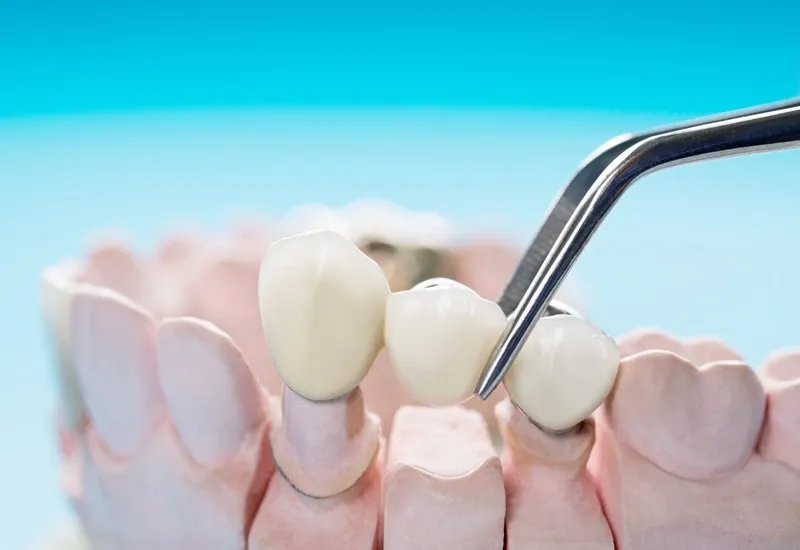
Are Dental Bridges Comfortable? What Patients Need to Know

Dr. Uvika Singh
01 May 2025
Dental bridges are a popular option for people with missing teeth. They help restore a complete smile, improve how you eat and speak, and keep your mouth healthy. However, many potential patients wonder: Are dental bridges comfortable?
Here we will learn how comfortable dental bridges are along with other information about the topic.

Understanding Dental Bridges
Before we talk about comfort, it is important to know what are. A dental bridge is a fixed restoration that replaces one or more missing teeth. They are held in place by nearby teeth, called abutment teeth. They may also be secured using dental implants. The main goal of a dental bridge is to fill the gaps left by missing teeth. These help in restoring both your smile and its function.
Bridges can be made from different materials, such as porcelain, ceramic, or metal. These materials are chosen for their strength and appearance. Also, they can be customized to match the color and shape of your natural teeth.
Dental bridges not only enhance your smile. These also help prevent other oral health problems caused by missing teeth.
For example, gaps can lead to misalignment, difficulty chewing, and even jaw issues over time. Understanding these factors is key to discussing how comfortable dental bridges can be.
Are Dental Bridges Comfortable?
The comfort level of dental bridges can differ from person to person. Many patients find that, once their dental bridges are properly fitted, they feel natural and greatly enhance their quality of life. However, some people may experience discomfort during the adjustment period after getting the bridge.
Initial Discomfort
After getting a dental bridge, it is common to feel some discomfort. This discomfort can come from preparing the abutment teeth, the anesthesia used during the procedure, or simply getting used to a new dental appliance. Usually, this discomfort goes away within a few days as your mouth adjusts. Most patients can expect mild soreness or sensitivity. This is especially in the areas where the crowns were placed.
Long-Term Comfort
Once you get through the initial adjustment period, most people report that their dental bridges feel comfortable. The materials used for the bridge are designed to mimic the feel of natural teeth. It will be allowing you to chew and speak normally. Many individuals are pleasantly surprised at how quickly they adapt to their bridges, often forgetting they even have them after a short time. This sense of normalcy can really boost your confidence.
Adjustments
If you still feel discomfort after the initial healing period, it might mean that your bridge doesn’t fit correctly. If this happens, it is important to see your dentist for adjustments. Keeping an eye on how the bridge feels and communicating any issues with your dental provider is crucial. This is because they can make small changes to enhance your comfort.
Overall, while some initial discomfort is normal. Most patients find that dental bridges become a comfortable and natural part of their mouths with time.
Pain with Dental Bridges and Its Causes.
While many patients feel minimal pain after getting dental bridges, some may experience discomfort. Common sources of pain include tooth sensitivity in the abutment teeth. It can happen after the crowns are placed due to enamel removal during preparation.
An improper fit can also lead to discomfort. This is because a bridge that doesn't fit well might put pressure on the gums or surrounding teeth. If this occurs, it is important to consult a dentist for adjustments. Additionally, gum irritation can happen if food particles get trapped. So, maintaining good oral hygiene is crucial.
Pros and Cons of Dental Bridges,
Let’s explore dental bridges pros and cons here.
- Restoration of Functionality: Dental bridges restore the ability to chew and speak effectively. They are allowing individuals to enjoy a wider range of foods and engage in social interactions comfortably. This restoration of function is not just about convenience. It also plays a vital role in maintaining a balanced diet, which is essential for overall health.
- Improved Aesthetics: Bridges fill the gaps in the smile, enhancing facial appearance and boosting confidence. A complete smile can significantly affect self-esteem, influencing how they perceive their overall attractiveness.
- Preventing Teeth Shifting: By filling the gaps left by missing teeth, dental bridges help maintain the alignment of surrounding teeth. These also reduce the risk of shifting and misalignment. This preventive aspect is crucial. This is because misaligned teeth can lead to further dental complications, such as uneven wear and increased risk of cavities.
- Durability: With proper care, dental bridges can last many years. This makes them a long-term solution for missing teeth. The longevity of bridges means that patients can enjoy the benefits for an extended period without having to frequently replace their dental work.
- Protection for Abutment Teeth: By placing crowns on the abutment teeth, dental bridges provide extra protection against wear and tear. This added layer can help prevent future dental problems for those teeth, contributing to overall oral health.
- Initial Discomfort: As mentioned earlier, some patients may experience discomfort during the adjustment period. This is a natural response as the mouth adapts to the new structure.
- Potential for Tooth Sensitivity: Following placement, some individuals may experience sensitivity in the abutment teeth. This is particularly if they were prepared for crowns. This sensitivity can be temporary. However, if it persists, it should be discussed with a dental professional.
- Maintenance: While dental bridges are durable, they require regular dental check-ups and proper oral hygiene to maintain their integrity. Patients must commit to a diligent oral care routine to avoid complications that could arise from neglect.
- Cost: The cost of dental bridges can be significant, especially if dental insurance does not cover the procedure. Patients should weigh this investment against the benefits, considering both immediate and long-term financial implications.
“The man with a toothache thinks everyone happy whose teeth are sound.
— George Bernard Shaw”
A Guide to Adjust to Dental Bridges
Adjusting to dental bridges can take time, but there are several strategies that can facilitate a smoother transition. Here are some on how to adjust to dental bridges effectively.
Take Pain Relief as Needed
If discomfort is experienced after the procedure, using over-the-counter pain relief medications can help manage any pain. Always follow the dosage recommendations and consult your dentist if pain persists.
Soft Diet
In the initial days following the placement of a dental bridge, it is advisable to stick to a soft diet. Foods that require minimal chewing can help ease the adjustment process and reduce discomfort.
Hard or sticky foods can put undue pressure on the dental bridge and surrounding teeth. These foods should be avoided, especially during the adjustment period.
Practice Good Oral Hygiene
Maintaining excellent oral hygiene is crucial for the longevity of dental bridges. Brush gently around the bridge and floss daily to keep the area clean and free from plaque.
Regular Dental Visits
Schedule regular check-ups with your dentist to monitor the condition of the bridge and surrounding teeth. Early detection of any issues can prevent discomfort and complications.
If discomfort or problems arise, communicate with your dentist promptly. They can make adjustments or provide solutions to enhance comfort.
Dental Bridge Comfort Tips: Effective Ways to Manage Discomfort
Maximizing dental bridges comfort is achievable with a few practical tips. Here are dental bridges comfort tips that can help you to feel more at ease.
- Drinking plenty of water can help flush out food particles and keep the mouth moist. This is particularly important for those who may experience dry mouth, which can lead to discomfort.
- During the adjustment period, it may be wise to avoid extremely hot or cold foods that could exacerbate sensitivity in the area around the bridge.
- Use a soft-bristled toothbrush and brush gently around the bridge and abutment teeth. This approach minimizes irritation to the gums while maintaining oral hygiene.
- If tooth sensitivity becomes problematic, using toothpaste specifically designed for sensitive teeth can provide relief.
- When eating, take small bites and chew on the opposite side of the mouth if sensitivity is present. This practice can help avoid discomfort while adjusting to the dental bridge.

Need Any Help?
Contact Us6. Smoking and other tobacco use can lead to complications, including gum disease, which can affect the comfort and longevity of dental bridges.
7. After the placement of dental bridges, follow all instructions provided by your dentist. Adhering to these guidelines can significantly impact comfort and recovery.
Final Thoughts
Dental bridges are a valuable solution for individuals dealing with missing teeth. While comfort levels can vary from person to person, but don’t worry. Many patients find that once adjusted, dental bridges feel natural and contribute positively to their quality of life.
Contact your dentist today in Oakland, Dr. Uvika Singh, at Advance Dental Concepts Oakland, to learn more about Are Dental Bridges Comfortable? What Patients Need to Know.
Resource:
Long-Term Benefits of Dental Bridges: A Smart Investment for Your Teeth
Share This:
Disclaimer
*This media/content or any other on this website does not prescribe, recommend, or prevent any treatment or procedure. Therefore, we highly recommend that you get the advice of a qualified dentist or other medical practitioners regarding your specific dental condition. *
